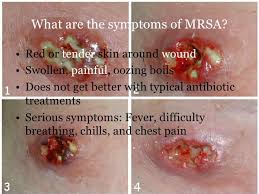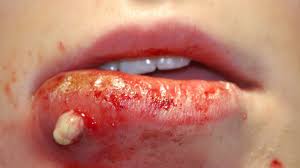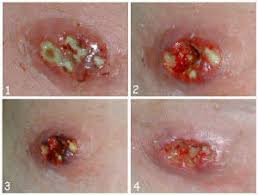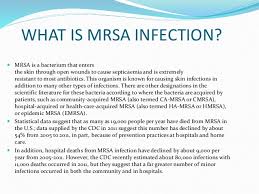Symptoms
Staph skin infections, including MRSA, generally start as swollen, painful red bumps that might resemble pimples or spider bites. The affected area might be:
- Warm to the touch
- Full of pus or other drainage
- Accompanied by a fever
These can quickly turn into deep, painful abscesses that require surgical draining. Sometimes the bacteria remain confined to the skin. But they can also burrow deep into the body, causing potentially life-threatening infections in bones, joints, surgical wounds, the bloodstream, heart valves and lungs.
When to see a doctor
Keep an eye on minor skin problems — pimples, insect bites, cuts and scrapes — especially in children. If wounds appear infected or are accompanied by a fever, see your doctor.
Causes
Different varieties of Staphylococcus aureus bacteria, commonly called "staph," exist. Staph bacteria are normally found on the skin or in the nose of about one-third of the population. The bacteria are generally harmless unless they enter the body through a cut or other wound, and even then they usually cause only minor skin problems in healthy people.
According to the Centers for Disease Control and Prevention, less than 2 percent of the population chronically carries the type of staph bacteria known as MRSA.
Antibiotic resistance
MRSA is the result of decades of often unnecessary antibiotic use. For years, antibiotics have been prescribed for colds, flu and other viral infections that don't respond to these drugs. Even when antibiotics are used appropriately, they contribute to the rise of drug-resistant bacteria because they don't destroy every germ they target. Bacteria live on an evolutionary fast track, so germs that survive treatment with one antibiotic soon learn to resist others.
Risk factors
Because hospital and community strains of MRSA generally occur in different settings, the risk factors for the two strains differ.
Risk factors for HA-MRSA
- Being hospitalized. MRSA remains a concern in hospitals, where it can attack those most vulnerable — older adults and people with weakened immune systems.
- Having an invasive medical device. Medical tubing — such as intravenous lines or urinary catheters — can provide a pathway for MRSA to travel into your body.
- Residing in a long-term care facility. MRSA is prevalent in nursing homes. Carriers of MRSA have the ability to spread it, even if they're not sick themselves.
Risk factors for CA-MRSA
- Participating in contact sports. MRSA can spread easily through cuts and abrasions and skin-to-skin contact.
- Living in crowded or unsanitary conditions. Outbreaks of MRSA have occurred in military training camps, child care centers and jails.
- Men having sex with men. Homosexual men have a higher risk of developing MRSA infections.
Complications
MRSA infections can resist the effects of many common antibiotics, so they are more difficult to treat. This can allow the infections to spread and sometimes become life-threatening.
MRSA infections may affect your:
- Bloodstream
- Lungs
- Heart
- Bones
- Joints
Tests and diagnosis
Doctors diagnose MRSA by checking a tissue sample or nasal secretions for signs of drug-resistant bacteria. The sample is sent to a lab where it's placed in a dish of nutrients that encourage bacterial growth. But because it takes about 48 hours for the bacteria to grow, newer tests that can detect staph DNA in a matter of hours are now becoming more widely available.







